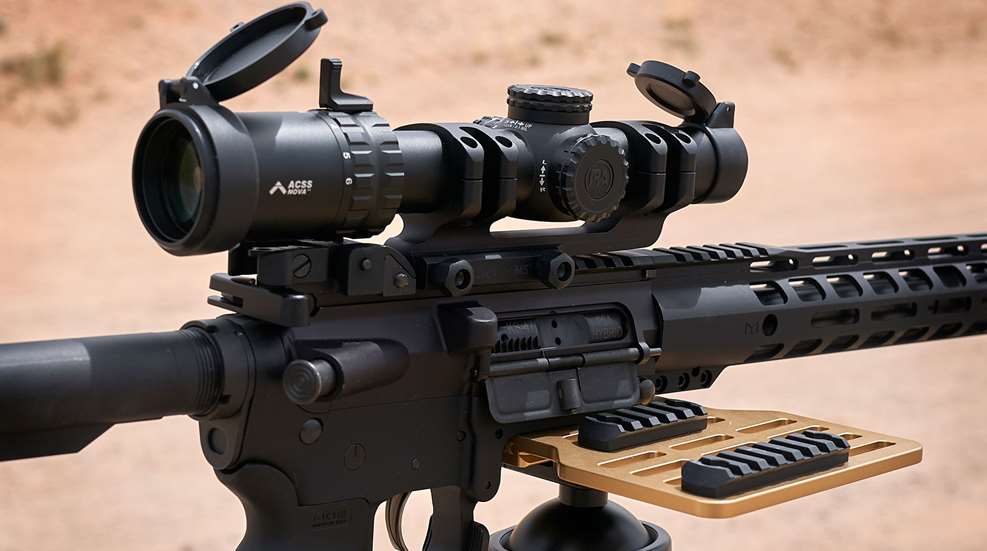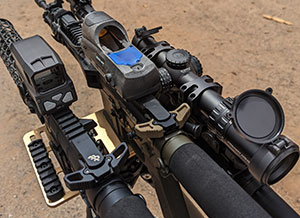
LPVO stands for Low Power Variable Optic, a term that came to prominence only recently, but it describes a type of riflescope that has been around for a while. The use of these scopes has changed dramatically in the last 20-odd years, both in terms of configuration and application.
LPVOs are defined as variable-magnification riflescopes that have the low-end magnification of 1X or close to it. Historically, there were always a few scopes out there along the lines of 1-3X, 1-4X, 1.25-4X or similar power. The first example was Zeiss’ Zielmulti optic that came out in the 1920s. The basic pattern of these scopes did not really change until close to the turn of the century. They typically have smallish objective diameters in the 20 to 30mm range, as it is difficult to design a riflescope that goes down to 1X while maintaining a large objective diameter. Until comparatively recently, though, these scopes were thought of as either dangerous-game scopes, driven-game scopes for hunting in Europe or as woods-rifle scopes. All three use cases benefit from the ability to rapidly engage a moving target at comparatively close ranges. These were never particularly high-volume market segments and, while riflescope manufacturers never ignored them, they were also never in any rush to invest a whole lot into innovation into this market.
The transition between low-power hunting scopes and modern tactical LPVOs happened for several reasons, with the process kicking off in the mid-1990s when Special Operations soldiers had to re-think their sighting equipment in the aftermath of the Battle of Mogadishu. In the meantime, the U.S. military adopted two different types of optical sights for different units and applications. The general purpose optical sight was the Aimpoint red-dot sight, while a rifleman's optic, of sorts, was Trijicon's four-power ACOG. Red dot sights (and holographics) were and are undeniably fast at close ranges, but lacked the ability to clearly identify targets at distance and engage them at distances where bullet drop started to come into effect. The 4x32mm ACOG was excellent for figuring out whether what you were looking at needed to be shot, but wasn't ideal at close ranges. Still, the brightly illuminated ACOG reticle with Bindon Aiming Concept (originally inspired by the Occluded Eye Gunsight) demonstrated the speed potential of magnified optics if you do the reticle illumination the correct way.
That's when the SOF people approached a few riflescope manufacturers to see if they could make an optic that would combine the capabilities of an Aimpoint and an ACOG. It was understood from the very beginning that this optic might not be quite as fast as a red dot on 1X or have the compactness and FOV (Field Of View) of the ACOG on 4X, but it could get close enough to both of those and offer capabilities that neither the ACOG nor the Aimpoint had. The manufacturer that ultimately stepped up to the plate was Schmidt & Bender. Hans Bender, a descendant of the original Schmidt family that started Schmidt & Bender, was running the company at the time and I was able to hear the original story from him. The resulting product was the 1.1-4x20 Short Dot riflescope that codified the functions of every other high quality LPVO that followed it. Not all of the scopes worked the same way, but that's how competition works. The market throws a bunch of options at the consumer and the best float to the top. The Short Dot used a somewhat unusual reticle illumination strategy, but it was truly day bright on 1X to get you close to a red dot experience. Unsurprisingly, given who made it, optical and mechanical quality of the Short Dot is absolutely superb, so on 4X it made for a really capable Designated Marksman scope aided by a mil-dot reticle and excellent elevation turret with BDC cams.
All of that was happening during the ill-conceived Assault Weapons Ban that lasted between 1994 and 2004, which inconvenienced millions of law-abiding citizens for a decade. The sunset of this law served as a kickoff for the emergence of a huge variety of different AR-15 pattern rifles. Some purists stuck with iron sights for their guns, but just about everyone else who could afford an optic bought one.

At around the same time, 3-gun competitions were becoming popular and quite a few stages required rapidly transitioning between targets close and far. Before too long, optics manufacturers took note of how large of a market all of that is and started rapidly releasing upgraded red-dot sights, prismatic sights and LPVOs. While red dots sights became increasingly more sophisticated either with compactness or with system level integration, without magnification, they can’t extend range.
Special Operations Forces, arguably, led the charge when it came to adopting LPVOs. Their selling point was always flexibility and it still is. Schmidt & Bender's Short Dot was and is expensive. Many other manufacturers offered LPVOs in myriad configurations. Magnification ratios slowly inched up and the more affordable ones became more capable over time. A couple of different configurations emerged as the dominant patterns. The original Short Dot was an FFP (First Focal Plane) design that is a bit harder to make on a budget with a daylight-bright dot, although some of that can be partially compensated with better reticle design. Currently manufactured Schmidt & Bender Short Dot Dual CC 1-8x24, Vortex Razor Gen3 1-10x24mm and SAI6 1-6x24mm are current examples of this pattern. The competing configuration is demonstrated by the Vortex Razor Gen2 1-6x24 that is a SFP (Second Focal Plane) design with bright fiber-dot illumination. There are now similarly configured LPVOs available for as little as $350, such as the Primary Arms SLx Nova 1-6x24mm.
When sufficiently robust LPVOs first became available, it seemed like everyone bought one, whether it was a good fit for them or not. If you are only looking to go fast, an LPVO is a good choice, but a quality holographic or reflex sight is probably going to be better (more on that in a bit) and will weigh less. If you practice diligently, the speed difference between a high quality LPVO on 1X and a similarly high-quality, non-focusing optic is small, but measurable. As the distances get longer, LPVOs start to pull ahead.

The reason why non-focusing optics (i.e. sights that do not have ay focal planes inside an optic within the line of sight) are little faster is due to a number of factors. The biggest one is that no matter how good modern LPVOs are on 1X, red dots and holographic sights that do not have a specific exit pupil are still easier to get behind in a hurry, as your eye does not have to be perfectly lined up behind an optic. LPVOs that have large exit pupils do not have to be perfect either, but their eye box is still a little more restrictive. A more subtle reason is the perspective shift you get with LPVOs. With a holographic sight, you are essentially looking through a glass pane, so you see everything from a perspective of the location of your eyeball. With a riflescope, you see everything from a perspective of the location of the objective lens of the optic that is typically 12 to 15 inches farther forward. It may not seem like much, but it makes a difference at “across the room” distances. Lastly, there is a matter of slight distortion in the edges of the FOV. It is a minor effect, but it is there. That is why when really looking for small speed differences, holographic sights that offer the most undistorted FOV edge slightly ahead of even the best of red dots, with LPVOs close behind. If you are looking for a little magnification while keeping the gun trim and light, a compact prismatic scope might be a better choice. However, if you are looking for long-range precision, there are plenty of higher magnification optics out there that will do the trick.
If you are looking to do all of the above in a pinch, a good quality LPVO is your huckleberry. As the famous quote goes: “Jack of all trades, master of none, but oftentimes better than master of one”. If you are setting up an AR-15 for the unexpected, when you do not know what you might be facing, LPVO is the way to go.





































